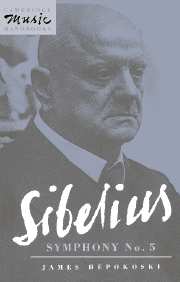Book contents
- Frontmatter
- Contents
- Preface
- 1 Introduction: Sibelius and the problem of ‘modernism’
- 2 The crisis, 1909–14: ‘Let's let the world go its own way’
- 3 Reassessed compositional principles, 1912–15: the five central concepts
- 4 Of Heaven's door and migrating swans: composing a confession of faith
- 5 Musical process and architecture: a proposed overview
- 6 Editions and performance tempos: a brief note
- Notes
- Select bibliography
- Index
- Mahler: Symphony No. 3
2 - The crisis, 1909–14: ‘Let's let the world go its own way’
Published online by Cambridge University Press: 11 January 2010
- Frontmatter
- Contents
- Preface
- 1 Introduction: Sibelius and the problem of ‘modernism’
- 2 The crisis, 1909–14: ‘Let's let the world go its own way’
- 3 Reassessed compositional principles, 1912–15: the five central concepts
- 4 Of Heaven's door and migrating swans: composing a confession of faith
- 5 Musical process and architecture: a proposed overview
- 6 Editions and performance tempos: a brief note
- Notes
- Select bibliography
- Index
- Mahler: Symphony No. 3
Summary
The Fifth Symphony is the first large-scale work that Sibelius composed fully on the other side of his confrontation with the New Music revolutions. Even more than the major works that immediately precede it, The Bard (1913, rev. 1914), Luonnotar (1913), and The Oceanides (1914), it marks his exit from a prolonged crisis of self-reappraisal, coupled with an uneasy acceptance of the withdrawal phase of his own modernism. Although he had entered the 1909–14 period with hopes of still contending publicly as a competing modernist, he left it resigned to failure, at least as judged by the marketplace terms of the institution of art music; resigned to a geographical and spiritual separation from the new currents of continental music; resigned to what he habitually called his Alleingefühl (sense of being alone, or total ‘otherness’); and resigned, ultimately, to a solitary, interior journey of phenomenological concentration that seems to have had as its aim the uncovering of the hidden core, or ‘being’, of Klang (musical ‘sound’) itself.
One way to approach all of this is to underscore the degree to which the physical and psychological patterns of Sibelius's life in these years of change were split between two radically different modes of existence: the isolation of ‘Ainola’, his spare, idyllically rustic home in the forests of Järvenpää; and, in the sharpest possible contrast, his occasional visits to the grand capitals of European music, especially Berlin, Paris, and London.
- Type
- Chapter
- Information
- Sibelius: Symphony No. 5 , pp. 10 - 18Publisher: Cambridge University PressPrint publication year: 1993
- 1
- Cited by



